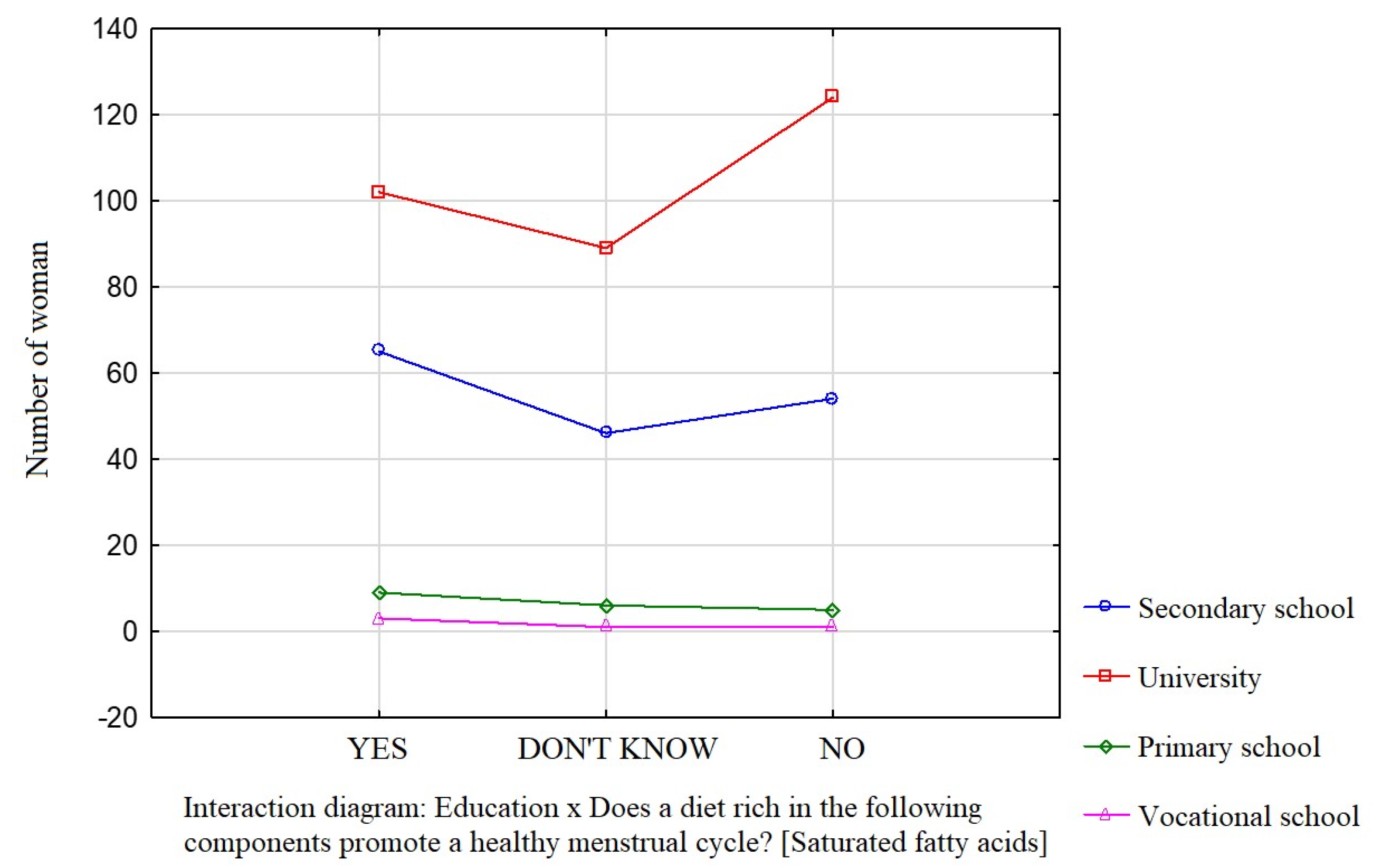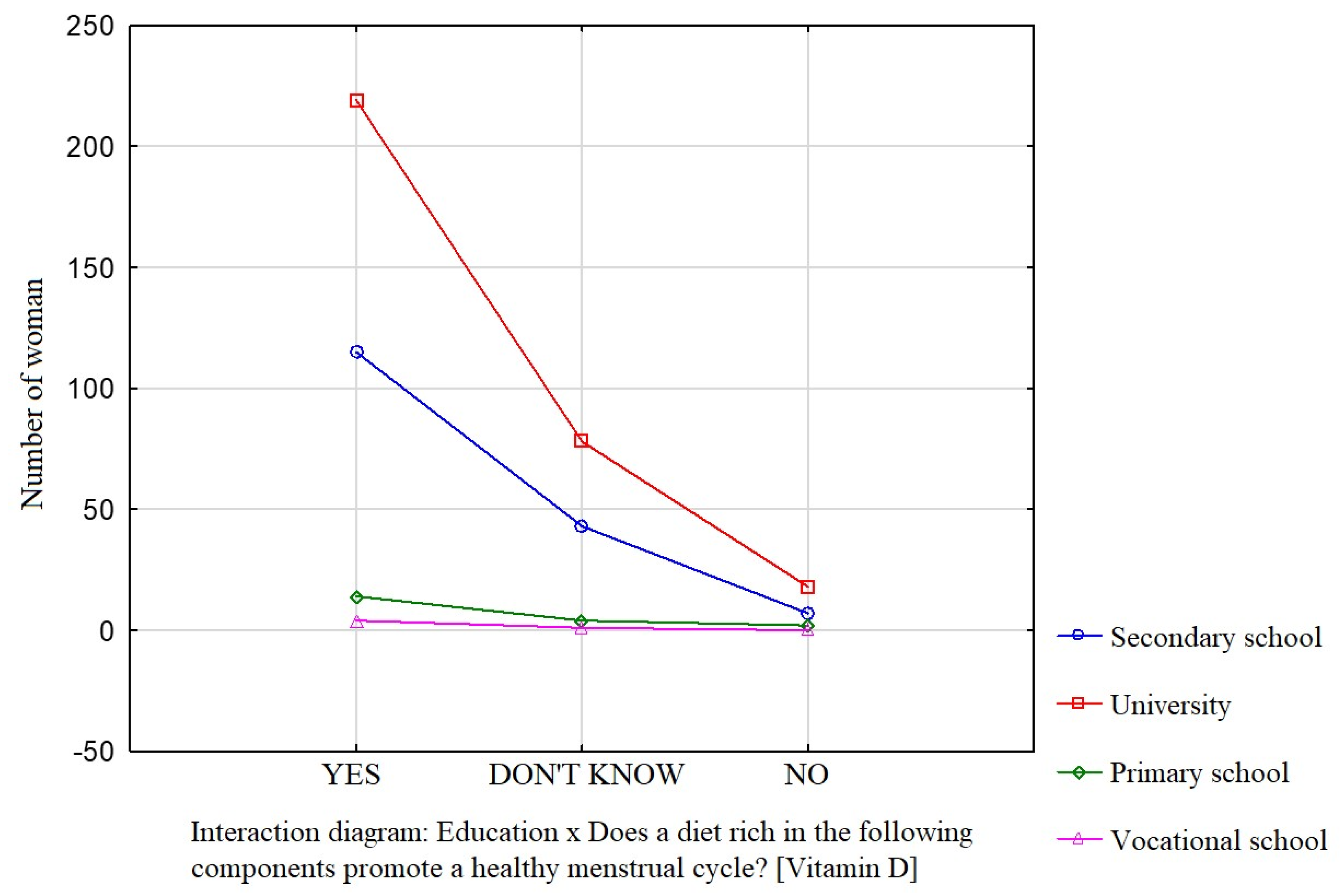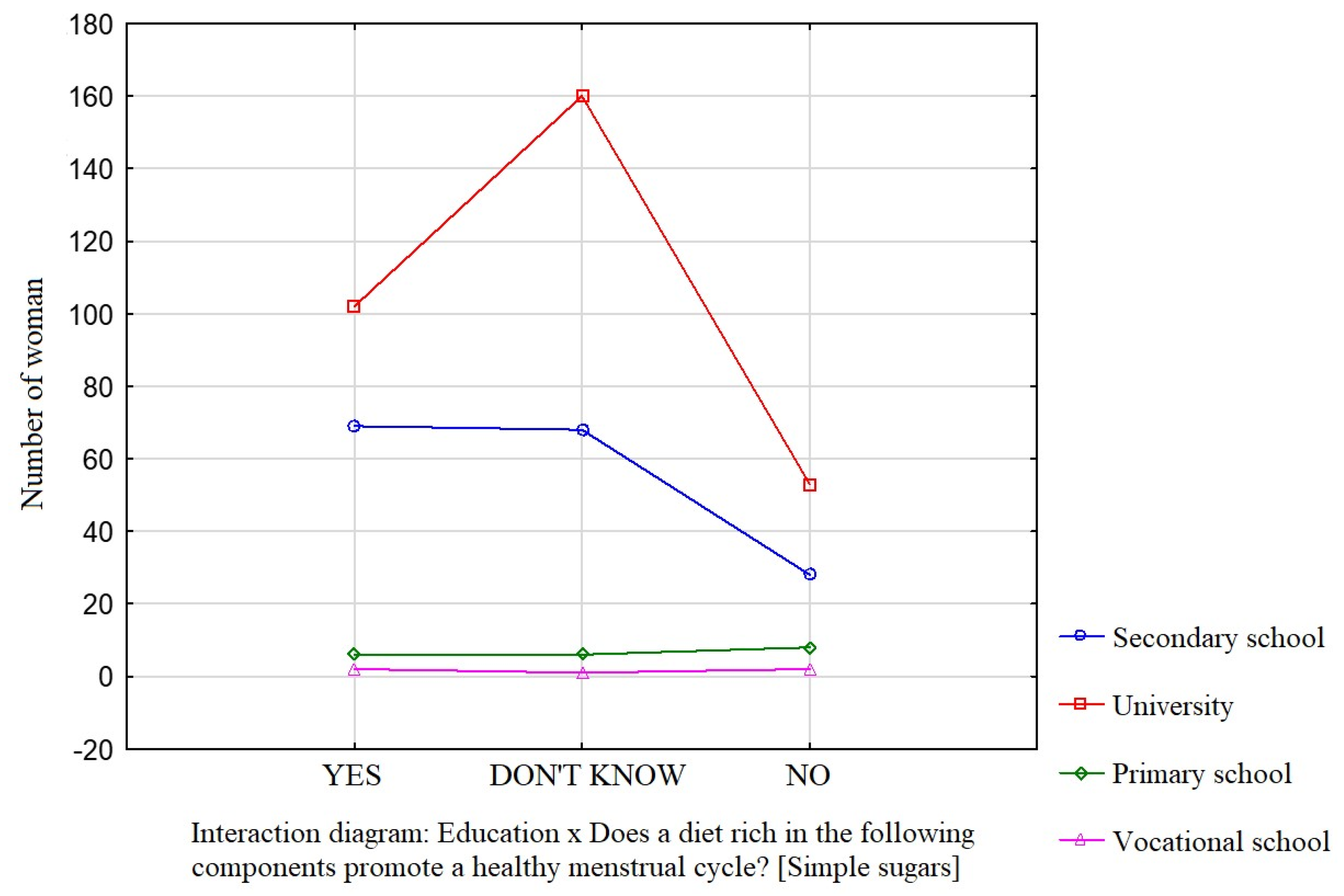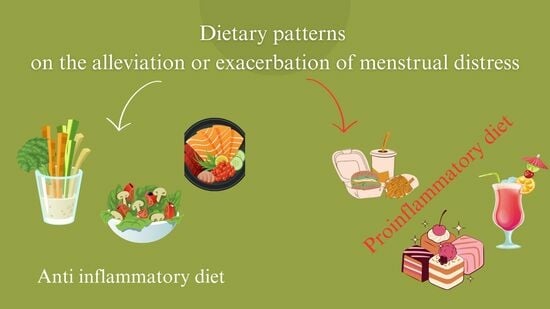An Assessment of Women’s Knowledge of the Menstrual Cycle and the Influence of Diet and Adherence to Dietary Patterns on the Alleviation or Exacerbation of Menstrual Distress
Abstract
:1. Introduction
2. Materials and Methods
2.1. Study Design
- -
- Age: 18–40 years;
- -
- Absence of serious illnesses that constitute exclusion criteria;
- -
- Informed consent to participate in the study.
- -
- Amenorrhea (absence of menstruation);
- -
- Miscarriage in the previous 6 months;
- -
- Pregnancy;
- -
- Presence of biological offspring;
- -
- Use of hormonal drugs (other than contraceptives), steroids, antidepressants, sleeping pills, or sedatives in the previous 6 months or directly before the trial;
- -
- Chronic diseases and metabolic disorders, including type 1 and 2 diabetes, insulin resistance, polycystic ovary syndrome, endometriosis, sterility, infertility, hormonal disorders, thyroid disorders, kidney disorders, asthma, Crohn’s disease, anemia, eating disorders, epilepsy, rheumatoid arthritis, cancer, HPV infection;
- -
- Diagnosed gynecological diseases or disorders, including congenital abnormalities of the reproductive tract;
- -
- Pelvic floor disorders;
- -
- Lack of consent to participate in the study.
2.2. Study Tools and Data Collection
- -
- <18.5 kg/m2—underweight;
- -
- 18.5–24.99 kg/m2—normal weight;
- -
- 25.0–29.99 kg/m2—overweight;
- -
- 30.0–34.99 kg/m2—stage I obesity;
- -
- >35 kg/m2—stage II obesity.
2.3. Dietary Patterns
2.4. Data Processing and Statistical Analysis
3. Results
3.1. Selected Menstrual Health Parameters
3.2. The Influence of Diet and Eating Habits on the Menstrual Cycle
3.3. Evaluation of Menstrual Health Parameters and Eating Habits in Women Adhering to Two Dietary Models
4. Discussion
Strengths and Limitations
5. Conclusions
Author Contributions
Funding
Institutional Review Board Statement
Informed Consent Statement
Data Availability Statement
Acknowledgments
Conflicts of Interest
References
- Kocaoz, S.; Cirpan, R.; Degirmencioglu, A.Z. The prevalence and impacts heavy menstrual bleeding on anemia, fatigue and quality of life in women of reproductive age. Pak. J. Med. Sci. 2019, 35, 365–370. [Google Scholar] [CrossRef] [PubMed]
- MacGregor, B.; Allaire, C.; Bedaiwy, M.A.; Yong, P.J.; Bougie, O. Disease Burden of Dysmenorrhea: Impact on Life Course Potential. Int. J. Womens Health 2023, 15, 499–509. [Google Scholar] [CrossRef] [PubMed]
- Schoep, M.E.; Nieboer, T.E.; van der Zanden, M.; Braat, D.D.M.; Nap, A.W. The impact of menstrual symptoms on everyday life: A survey among 42,879 women. Am. J. Obstet. Gynecol. 2019, 220, 569. [Google Scholar] [CrossRef]
- Yamada, K.; Kamagata, E. Reduction of quality-adjusted life years (QALYs) in patients with premenstrual dysphoric disorder (PMDD). Qual. Life Res. 2017, 26, 3069–3073. [Google Scholar] [CrossRef] [PubMed]
- Fernández-Martínez, E.; Onieva-Zafra, M.D.; Parra-Fernández, M.L. The Impact of Dysmenorrhea on Quality of Life among Spanish Female University Students. Int. J. Environ. Res. Public Health 2019, 16, 713. [Google Scholar] [CrossRef] [PubMed]
- Yoshino, O.; Takahashi, N.; Suzukamo, Y. Menstrual symptoms, health-related quality of life, and work productivity in Japanese women with dysmenorrhea receiving different treatments: Prospective observational study. Adv. Ther. 2022, 39, 2562–2577. [Google Scholar] [CrossRef] [PubMed]
- Mizuta, R.; Maeda, N.; Tashiro, T.; Suzuki, Y.; Oda, S.; Komiya, M.; Urabe, Y. Quality of life by dysmenorrhea severity in young and adult Japanese females: A web-based cross-sectional study. PLoS ONE 2023, 18, e0283130. [Google Scholar] [CrossRef] [PubMed]
- ACOG Committee Opinion No. 760: Dysmenorrhea and Endometriosis in the Adolescent. Obstet. Gynecol. 2018, 132, 249–258. [CrossRef]
- Unnisa, H.; Annam, P.; Gubba, N.C.; Begum, A.; Thatikonda, K. Assessment of quality of life and effect of non-pharmacological management in dysmenorrhea. Ann. Med. Surg. 2022, 81, 104407. [Google Scholar] [CrossRef]
- Kanchan, Y.; Rizwana, S.; Charu, S.; Kalpna, G.; Jitendra, J.; Goury, C. Menstrual pattern in medical students and their knowledge and attitude towards it. Int. J. Med. Health Res. 2018, 4, 19–22. [Google Scholar]
- Bauman, D.; Sommer, A.; Hamer, T.; Noy, D.; Elami, M.; Yogev, S.S.; Magiel, E.; Revel-Vilk, S. Reduced Activity and Quality of Life in Women Soldiers with Heavy Menstrual Bleeding and Dysmenorrhea. J. Pediatr. Adolesc. Gynecol. 2022, 35, 53–58. [Google Scholar] [CrossRef] [PubMed]
- Knopczyk, J.; Kaczorowska, A.; Mroczek, A. Influence of menstruation on pain of lumbar–sacra spine in women aged 20–35. In Holistic Dimension of Modern Medicine, 1st ed.; Krajewska-Kułak, E., Łukaszuk, C., Lewko, J., Kułak, W., Eds.; Uniwersytet Medyczny w Białymstoku: Białystok, Poland, 2021; Volume 8, pp. 973–982. ISBN 978-83-959846-8-6. (In Polish) [Google Scholar]
- Szymańska, K.; Jaworski, M.; Gotlib, J.; Panczyk, M. Elements of eating pattern and intensity of dysmenorrhea—A cross-sectional study in sample of Polish women. Med. Sci. Pulse 2020, 14, 10–17. [Google Scholar] [CrossRef]
- Graff, E.; Vedantam, S.; Parianos, M.; Khakoo, N.; Beiling, M.; Pearlman, M. Dietary Intake and Systemic Inflammation: Can We Use Food as Medicine? Curr. Nutr. Rep. 2023, 12, 247–254. [Google Scholar] [CrossRef] [PubMed]
- Wohlgemuth, K.J.; Arieta, L.R.; Brewer, G.J.; Hoselton, A.L.; Gould, L.M.; Smith-Ryan, A.E. Sex differences and considerations for female specific nutritional strategies: A narrative review. J. Int. Soc. Sports Nutr. 2021, 18, 27–46. [Google Scholar] [CrossRef] [PubMed]
- Cochran, W.G. Sampling Techniques, 3rd ed.; John Wiley & Sons: New York, NY, USA, 1977. [Google Scholar]
- Główny Urząd Statystyczny. Available online: https://stat.gov.pl/ (accessed on 22 January 2023).
- Onieva-Zafra, M.D.; Fernández-Martínez, E.; Abreu-Sánchez, A.; Iglesias-López, M.T.; García-Padilla, F.M.; Pedregal-González, M.; Parra-Fernández, M.L. Relationship between Diet, Menstrual Pain and other Menstrual Characteristics among Spanish Students. Nutrients 2020, 12, 1759. [Google Scholar] [CrossRef] [PubMed]
- Pejčić, A.; Janković, S. Risk factors for dysmenorrhea among young adult female university students. Ann. Dell’ist. Super. Di Sanita 2016, 52, 98–103. [Google Scholar] [CrossRef]
- Di Cintio, E.; Parazzini, F.; Tozzi, L.; Luchini, L.; Mezzopane, R.; Marchini, M.; Fedele, L. Dietary habits, reproductive and menstrual factors and risk of dysmenorrhoea. Eur. J. Epidemiol. 1997, 13, 925–930. [Google Scholar] [CrossRef]
- Grandi, G.; Ferrari, X.; Cannoletta, P.; Volpe, C.A. Prevalence of menstrual pain in young women: What is dysmenorrhea? J. Pain Res. 2012, 2012, 169–174. [Google Scholar] [CrossRef]
- Teul, I.; Kliś, K.; Jarzębak, K.; Wronka, I. The prevalence and correlates of menstrual pain in healthy university students. Ann. Acad. Medicae Stetin. 2014, 60, 89–94. [Google Scholar]
- Zurawiecka, M.; Wronka, I. Association of primary dysmenorrhea with anthropometrical and socioeconomic factors in polish university students. J. Obstet. Gynaecol. Res. 2018, 44, 1259–1267. [Google Scholar] [CrossRef]
- Barcikowska, Z.; Wójcik-Bilkiewicz, K.; Sobierajska-Rek, A.; Grzybowska, M.E.; Wąż, P.; Zorena, K. Dysmenorrhea and Associated Factors among Polish Women: A Cross-Sectional Study. Pain Res. Manag. 2020, 2020, 6161536. [Google Scholar] [CrossRef] [PubMed]
- Hirschberg, A.L. Sex hormones, appetite and eating behaviour in women. Maturitas 2012, 71, 248–256. [Google Scholar] [CrossRef] [PubMed]
- Kamemoto, K.; Yamada, M.; Matsuda, T.; Ogata, H.; Ishikawa, A.; Kanno, M.; Miyashita, M.; Sakamaki-Sunaga, M. Effects of menstrual cycle on appetite-regulating hormones and energy intake in response to cycling exercise in physically active women. J. Appl. Physiol. 2022, 132, 224–235. [Google Scholar] [CrossRef] [PubMed]
- Saad, G.; Strenstron, E. Calories, beauty, and ovulation: The effects of the menstrual cycle on food and appearance-related consumption. J. Cons. Psychol. 2012, 22, 102–113. [Google Scholar] [CrossRef]
- Lefebvre, M.; Hengartner, M.P.; Tronci, E.; Mancini, T.; Ille, F.; Röblitz, S.; Krüger, T.; Leeners, B. Food preferences throughout the menstrual cycle—A computer-assisted neuro-endocrino-psychological investigation. Physiol. Behav. 2022, 255, 113943. [Google Scholar] [CrossRef] [PubMed]
- Murakami, K.; Sasaki, S.; Takahashi, Y.; Uenishi, K.; Watanabe, T.; Kohri, T.; Yamasaki, M.; Watanabe, R.; Baba, K.; Shibata, K.; et al. Dietary glycemic index is associated with decreased premenstrual symptoms in young Japanese women. Nutrition 2008, 24, 554–561. [Google Scholar] [CrossRef] [PubMed]
- Tucci, S.A.; Murphy, L.E.; Boyland, E.J.; Dye, L.; Halford, J.C. Oral contra—Ceptive effects on food choice during the follicular and luteal phases of the menstrual cycle: A laboratory based study. Appetite 2010, 55, 388–392. [Google Scholar] [CrossRef]
- Gorczyca, A.M.; Sjaarda, L.A.; Mitchell, E.M.; Mitchell, E.M.; Perkins, N.J.; Schliep, K.C.; Wactawski-Wende, J.; Mumford, S.L. Changes in macronutrient, micronutrient, and food group intakes throughout the menstrual cycle in healthy, premenopausal women. Eur. J. Nutr. 2016, 55, 1181–1188. [Google Scholar] [CrossRef]
- Kazama, M.; Maruyama, K.; Nakamura, K. Prevalence of dysmenorrhea and its correlating lifestyle factors in Japanese female junior high school students. Tohoku J. Exp. Med. 2015, 236, 107–113. [Google Scholar] [CrossRef]
- Naraoka, Y.; Hosokawa, M.; Minato-Inokawa, S.; Sato, Y. Severity of Menstrual Pain Is Associated with Nutritional Intake and Lifestyle Habits. Healthcare 2023, 11, 1289. [Google Scholar] [CrossRef]
- Policy Brief: Women and Menstruation in the EU. Available online: https://eurohealth.ie/policy-brief-women-and-menstruation-in-the-eu-2/#_edn17 (accessed on 23 October 2023).
- Tjon-A-Ten, V. (Ed.) Menstrual Hygiene: A Neglected Condition for the Achievement of Several Millennium Development Goals; Europe External Policy Advisors: Brussels, Belgium, 2007; pp. 1–24. [Google Scholar]
- Mohammed, S.; Larsen-Reindorf, R.E. Menstrual knowledge, sociocultural restrictions, and barriers to menstrual hygiene management in Ghana: Evidence from a multi-method survey among adolescent schoolgirls and schoolboys. PLoS ONE 2020, 15, 0241106. [Google Scholar] [CrossRef] [PubMed]
- Haque, S.; Rahman, M.; Itsukow, K.; Mutahara, M.; Sakisaka, K. The effect of a school-based educational intervention on menstrual health: An intervention study among adolescent girls in Bangladesh. BMJ Open 2014, 4, 004607. [Google Scholar] [CrossRef] [PubMed]
- Ayoola, A.B.; Zandee, G.L.; Adams, Y.J. Women’s knowledge of ovulation, the menstrual cycle, and its associated reproductive changes. Birth 2016, 43, 255–262. [Google Scholar] [CrossRef] [PubMed]
- Lundsberg, L.S.; Pal, L.; Gariepy, A.M.; Xu, X.; Chu, M.C.; Illuzzi, J.L. Knowledge, attitudes, and practices regarding conception and fertility: A population-based survey among reproductive-age United States women. Fertil. Steril. 2014, 101, 767–774. [Google Scholar] [CrossRef] [PubMed]
- Tingle, C.; Vora, S. Break the Barriers: Girls’ Experiences of Menstruation in the UK Plan International UK. 2018. Available online: https://plan-uk.org/file/plan-uk-break-the-barriers-report-032018pdf/download?token=Fs-HYP3v (accessed on 20 October 2023).
- Menstruation. Quantitative and Qualitative Research Report. Available online: https://kulczykfoundation.org.pl/uploads/media/default/0001/05/0fbe618f4aa748170c8b3f096367e2c607888eb8.pdf (accessed on 23 October 2023).
- Fernández-Martínez, E.; Onieva-Zafra, M.D.; Abreu-Sánchez, A.; Fernández-Muñóz, J.J.; Parra-Fernández, M.L. Absenteeism during menstruation among nursing students in Spain. Int. J. Environ. Res. Public Health 2019, 17, 53. [Google Scholar] [CrossRef] [PubMed]
- Deutch, B.; Bonefeld Jørgensen, E.; Hansen, J.C. Menstrual discomfort in Danish women reduced by dietary supplements of omega-3 PUFA and B12 (fish oil or seal oil capsules). Nutr. Res. 2000, 20, 621–631. [Google Scholar] [CrossRef]
- Hansen, S.O.; Knudsen, U.B. Endometriosis, dysmenorrhoea and diet. Eur. J. Obstet. Gynecol. Reprod. Biol. 2013, 169, 162–171. [Google Scholar] [CrossRef]
- Najafi, N.; Khalkhali, H.; Moghaddam Tabrizi, F.; Zarrin, R. Major dietary patterns in relation to menstrual pain: A nested case control study. BMC Womens Health 2018, 18, 69. [Google Scholar] [CrossRef]
- Bajalan, Z.; Alimoradi, Z.; Moafi, F. Nutrition as a potential factor of primary dysmenorrhea: A systematic review of observational studies. Gynecol. Obstet. Investig. 2019, 84, 209–224. [Google Scholar] [CrossRef]



| Frequency of Consumption as Defined in FFQ | Conversion Factor to Daily Frequency |
|---|---|
| Less than once a month | 0.00 |
| 1–3 times a month | 0.07 |
| 1–2 times a week | 0.21 |
| 3–4 times a week | 0.50 |
| 5–6 times a week | 0.79 |
| Once daily | 1.00 |
| Twice or more daily | 2.00 |
| Sociodemographic Parameters | N | N [%] | p-Value |
|---|---|---|---|
| Place of residence | <0.05 | ||
| 254 | 50.3% | |
| 110 | 21.8% | |
| 141 | 27.9% | |
| Age | <0.05 | ||
| 198 | 39.2% | |
| 307 | 60.8% | |
| Marital status | <0.05 | ||
| 116 | 23.0% | |
| 252 | 49.9% | |
| 137 | 27.1% | |
| Education | <0.05 | ||
| 20 | 4% | |
| 165 | 32.7% | |
| 315 | 62.3% | |
| 5 | 1% | |
| Professional status | <0.05 | ||
| 57 | 11.3% | |
| 159 | 31.5% | |
| 266 | 52.7% | |
| 23 | 4.5% |
| Mild Pain, N = 147 (29.1%) | Moderate Pain, N = 234 (46.4%) | Severe Pain, N = 124 (24.5%) | Kruskal–Wallis Test | ||||
|---|---|---|---|---|---|---|---|
| N | N% | N | N% | N | N% | ||
| Abdominal pain | 89 | 60.5 | 177 | 75.6 | 124 | 100 | 0.003 |
| Anxiety | 19 | 12.9 | 159 | 67.9 | 75 | 60.5 | 0.005 |
| Generalized pain | 23 | 15.6 | 173 | 73.9 | 117 | 94.3 | 0.002 |
| Uterine contractions | 106 | 72.1 | 170 | 72.6 | 95 | 76.6 | ns |
| Back pain | 91 | 61.2 | 178 | 76.0 | 97 | 78.2 | ns |
| Headache | 56 | 38.1 | 56 | 23.9 | 68 | 54.8 | 0.012 |
| Fatigue | 39 | 26.5 | 79 | 33.7 | 84 | 67.7 | 0.003 |
| Leg pain | 27 | 18.4 | 141 | 60.3 | 96 | 77.4 | 0.002 |
| Nausea | 11 | 7.5 | 17 | 7.3 | 10 | 8.0 | ns |
| Insomnia | 29 | 19.7 | 59 | 25.2 | 87 | 70.2 | 0.003 |
| Loss of appetite | 46 | 31.3 | 72 | 33.2 | 41 | 33.1 | ns |
| Diarrhea/constipation | 51 | 34.7 | 71 | 30.3 | 43 | 34.6 | ns |
| Heart palpitations | 12 | 8.2 | 24 | 10.3 | 27 | 21.8 | 0.041 |
| Intensity of Menstrual Pain | p-Value | |||||||||
|---|---|---|---|---|---|---|---|---|---|---|
| Total N = 505 | Mild | Moderate | Severe | Severe Menstrual Pain (Ref. Mild Menstrual Pain) | ||||||
| Daily Frequency | Daily Frequency | Daily Frequency | Daily Frequency | |||||||
| Refined cereal products | 1.4 | (0–2) | 1.2 | (0–2) | 1.5 | (0–2) | 1.7 | (0–2) | 0.0031 | 1.76 ** (1.06–1.98) |
| Whole-grain cereal products | 0.81 | (0–2) | 0.94 | (0–2) | 0.83 | (0–2) | 0.67 | (0–2) | 0.023 | 0.88 * (0.64–1.02) |
| Milk | 1.5 | (0–2) | 1.5 | (0–2) | 1.4 | (0–2) | 1.4 | (0–2) | ns | 0.92 (0.89–1.14) |
| Fermented milks | 0.3 | (0–2) | 0.3 | (0–2) | 0.4 | (0–2) | 0.3 | (0–2) | ns | 0.94 (0.91–1.09) |
| Sweetened dairy products | 1.5 | (0–2) | 1.5 | (0–2) | 1.7 | (0–2) | 1.0 | (0–2) | 0.0016 | 0.73 (0.62–1.07) |
| Fresh meat | 0.6 | (0–2) | 0.6 | (0–2) | 0.7 | (0–2) | 0.6 | (0–2) | ns | 1.02 (0.97–1.04) |
| Processed meat | 1.5 | (0–2) | 1.3 | (0–2) | 1.3 | (0–2) | 1.7 | (0–2) | 0.002 | 1.54 * (1.12–1.87) |
| Fish | 0.2 | (0–1) | 0.2 | (0–1) | 0.2 | (0–1) | 0.2 | (0–1) | ns | 1.03 (0.92–1.09) |
| Vegetable fats | 0.4 | (0–2) | 0.4 | (0–2) | 0.5 | (0–2) | 0.3 | (0–2) | ns | 0.91 (0.81–1.01) |
| Animal fats | 1.6 | (0–2) | 1.4 | (0–2) | 1.3 | (0–2) | 1.8 | (0–2) | 0.041 | 1.45 * (1.12–1.87) |
| Potatoes | 0.3 | (0–0.79) | 0.3 | (0–0.79) | 0.3 | (0–0.79) | 0.3 | (0–0.79) | ns | 1.02 (0.97–1.04) |
| Vegetables | 1.7 | (0–2) | 1.8 | (0–2) | 1.5 | (0–2) | 1.1 | (0–2) | 0.0027 | 0.53 ** (0.46–0.89) |
| Dry legumes | 0.3 | (0–1) | 0.3 | (0–1) | 0.3 | (0–1) | 0.3 | (0–1) | ns | 1.02 (0.97–1.05) |
| Nuts | 0.2 | (0–2) | 0.2 | (0–2) | 0.2 | (0–2) | 0.2 | (0–2) | ns | 1.02 (0.98–1.07) |
| Fruit | 1.7 | (0–2) | 1.9 | (0–2) | 1.6 | (0–2) | 1.4 | (0–2) | 0.0027 | 0.71 * (0.64–0.89) |
| Sugar and sweets | 1.6 | (0–2) | 1.1 | (0–2) | 1.4 | (0–2) | 1.9 | (0–2) | 0.001 | 2,19 ** (1.34–2.51) |
| Sweetened beverages | 0.5 | (0–2) | 0.3 | (0–2) | 0.7 | (0–2) | 0.4 | (0–2) | 0.0031 | 1.19 (1.01–1.36) |
| Fast foods | 0.7 | (0–1) | 0.7 | (0–1) | 0.8 | (0–1) | 0.7 | (0–1) | ns | 1.02 (0.97–1.08) |
| Alcohol | 0.4 | (0–2) | 0.6 | (0–2) | 0.4 | (0–2) | 0.5 | (0–2) | 0.042 | 0.91 (0.76–1.09) |
| Water | 1.7 | (0–2) | 1.6 | (0–2) | 1.1 | (0–2) | 1.8 | (0–2) | 0.0026 | 1.23 (1.01–1.46) |
| Model 1 (Anti-Inflammatory) | Model 2 (Proinflammatory) | p-Value in the Chi-Squared Test | |||
|---|---|---|---|---|---|
| N = 324 | N% | N = 181 | N% | ||
| Intensity of menstrual pain | 0.015 | ||||
| 136 | 41.9% | 11 | 6% | |
| 167 | 51.5% | 67 | 37% | |
| 21 | 6.6% | 103 | 57% | |
| Regular menstrual cycle | 0.041 | ||||
| 289 | 89.2% | 137 | 75.7% | |
| 35 | 10.8% | 44 | 24.3% | |
| Menstrual distress symptoms | 0.017 | ||||
| 111 | 34.3 | 35 | 19.3% | |
| 186 | 57.4% | 67 | 37% | |
| 27 | 8.3% | 79 | 43.6% | |
| Number of meals per day | 0.038 | ||||
| 89 | 27.5% | 46 | 25.5% | |
| 151 | 46.6% | 56 | 30.9% | |
| 84 | 25.9% | 79 | 43.6% | |
| Adherence to a special diet | 0.028 | ||||
| 33 | 10.2% | 48 | 26.5% | |
| 291 | 89.8% | 133 | 73.5% | |
| Consumption of light food products | 0.225 | ||||
| 81 | 25% | 54 | 29.8% | |
| 212 | 65.4% | 120 | 66.3% | |
| 31 | 9.6% | 7 | 3.9% | |
| Use of dietary supplements in the previous 6 months | 0.317 | ||||
| 263 | 81.2% | 161 | 89% | |
| 61 | 18.8% | 25 | 11% | |
| Increased food intake during menstruation | 0.037 | ||||
| 112 | 34.6% | 106 | 58.6% | |
| 212 | 65.4% | 75 | 41.4% | |
| Increased hunger during menstruation | 0.028 | ||||
| 79 | 24.4% | 94 | 51.9% | |
| 245 | 75.6% | 87 | 48.1% | |
| Knowledge about dietary components that influence mood during menstruation | 0.021 | ||||
| 247 | 76.2% | 102 | 56.4% | |
| 77 | 23.8% | 79 | 43.6% | |
| Knowledge about the menstrual cycle | 0.036 | ||||
| 105 | 32.4% | 98 | 54.1% | |
| 219 | 67.6% | 83 | 45.9% | |
| The influence of diet on the men-strual cycle | 0.029 | ||||
| 0 | - | 13 | 7.2% | |
| 54 | 16.7% | 36 | 19.9% | |
| 124 | 38.3% | 75 | 41.4% | |
| 146 | 45% | 57 | 31.5% | |
Disclaimer/Publisher’s Note: The statements, opinions and data contained in all publications are solely those of the individual author(s) and contributor(s) and not of MDPI and/or the editor(s). MDPI and/or the editor(s) disclaim responsibility for any injury to people or property resulting from any ideas, methods, instructions or products referred to in the content. |
© 2023 by the authors. Licensee MDPI, Basel, Switzerland. This article is an open access article distributed under the terms and conditions of the Creative Commons Attribution (CC BY) license (https://creativecommons.org/licenses/by/4.0/).
Share and Cite
Ciołek, A.; Kostecka, M.; Kostecka, J.; Kawecka, P.; Popik-Samborska, M. An Assessment of Women’s Knowledge of the Menstrual Cycle and the Influence of Diet and Adherence to Dietary Patterns on the Alleviation or Exacerbation of Menstrual Distress. Nutrients 2024, 16, 69. https://doi.org/10.3390/nu16010069
Ciołek A, Kostecka M, Kostecka J, Kawecka P, Popik-Samborska M. An Assessment of Women’s Knowledge of the Menstrual Cycle and the Influence of Diet and Adherence to Dietary Patterns on the Alleviation or Exacerbation of Menstrual Distress. Nutrients. 2024; 16(1):69. https://doi.org/10.3390/nu16010069
Chicago/Turabian StyleCiołek, Anna, Malgorzata Kostecka, Julianna Kostecka, Paulina Kawecka, and Monika Popik-Samborska. 2024. "An Assessment of Women’s Knowledge of the Menstrual Cycle and the Influence of Diet and Adherence to Dietary Patterns on the Alleviation or Exacerbation of Menstrual Distress" Nutrients 16, no. 1: 69. https://doi.org/10.3390/nu16010069
APA StyleCiołek, A., Kostecka, M., Kostecka, J., Kawecka, P., & Popik-Samborska, M. (2024). An Assessment of Women’s Knowledge of the Menstrual Cycle and the Influence of Diet and Adherence to Dietary Patterns on the Alleviation or Exacerbation of Menstrual Distress. Nutrients, 16(1), 69. https://doi.org/10.3390/nu16010069








